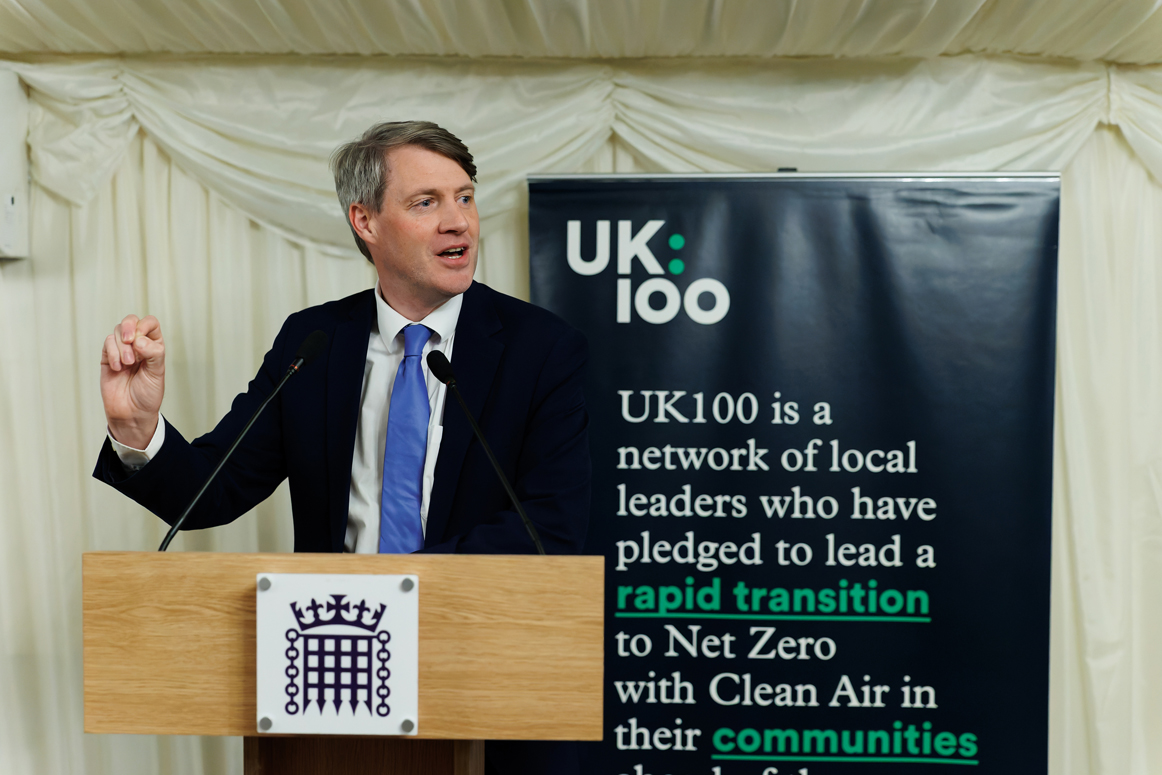 Warm homes and local energy: Christopher Hammond, Chief Executive of UK100 discusses the key to securing our future locally.
Warm homes and local energy: Christopher Hammond, Chief Executive of UK100 discusses the key to securing our future locally.
Last year was the planet’s hottest year on record, by far(1). The need for climate action is urgent, but it also presents one of the greatest economic opportunities of our lifetime(2). And the key to unlocking it lies in the hands of local leaders. But, as the Autumn Statement and recent National Planning Policy Framework update both recognised, progress is hampered by national barriers. Chief among those is the lack of warm, energy-efficient homes and an outdated energy grid designed.
But don’t despair, because across Britain, a quiet revolution is powering up. Despite the odds being stacked against them, pioneering councils are stepping up to deliver the warm homes and secure local energy networks we need.
Make no mistake, this revolution is happening despite, not because of, disjointed Whitehall policies and short-term funding pots. Empowered by a clear strategy and sustained investment local authorities can harness the skills, drive and public trust they already have to deliver warm homes and an affordable energy transition.
From Greater Manchester to Glasgow, trailblazing councils are proving that the future of the UK’s energy system must be local. Integrated solar, wind and storage projects tailored to community needs balance supply and demand at scale. Meanwhile, ambitious energy efficiency programmes are making homes warmer and slashing bills.

The power of LAEPs
The widening embrace of collaborative Local Area Energy Plans (LAEPs) will help optimise infrastructure for Net Zero in a fraction of the cost and time required by disjointed national schemes.
LAEPs take a whole-systems approach to managing local energy supply and demand. The plans combine renewables, storage, flexible use and smart grids tailored to each area’s unique geography, resources, and communities.
The benefits of this locally-led approach are clear. Analysis shows it could reduce costs by over two-thirds while almost doubling bill savings compared to one-size-fits-all national plans. Crucially, doing it from the bottom up also unlocks far greater social value for local residents and gives them more opportunities to influence their local energy systems and hopefully give them a greater stake in homegrown generation.

Greater Manchester’s pioneering Local Energy Market (LEM) is already balancing supply, demand, and storage options across the region’s 10 boroughs. The LEM is designed to meet the specific needs and circumstances of communities in each borough. Each borough has developed its own LAEP, identifying priority areas for insulation, heat pumps, EV infrastructure, and community engagement. It aims to meet the combined authority’s 2038 Net Zero target.
The LEM exemplifies the benefits of empowered local leadership and social value for residents. It is a partnership across the combined authority, local authorities, the DNO, and private and third-sector organisations. By taking a hyper-local approach, the LEM can maximise impact by tailoring the technology mix to match different neighbourhood infrastructure needs and opportunities.
But such trailblazers are exceptions in an opaque funding and policy landscape stacked against replication. In England under half of councils have even initial LAEPs. Compare that to Wales, where the devolved government aims to roll out LAEPs nationwide, aggregating each local authority plan into a National Energy Plan to enable effective comparison and integration. In Cardiff, the LAEP is already catalysing further investment plans, having established what is needed for the local area through the Cardiff Capital Region Energy Strategy.
It isn’t rocket science. Consistent, patient and devolved support empowers communities to map optimal local energy systems. As UK100’s Powers in Place and Chris Skidmore’s The Future is Local reports revealed, tailored area-based approaches like LAEPs cost over 65% less than disjointed national decarbonisation.
 Warming homes, growing jobs
Warming homes, growing jobs
On the flip side of the coin, councils are also delivering on energy efficiency. The cheapest and cleanest energy is the energy we don’t use. As landlords of 2.5 million social homes, they have the potential to seize their scale to upgrade housing at pace. And across the country, it is happening.
Wiltshire Council has committed to a 10-year programme to upgrade all of its approximately 5,000 council housing properties to EPC Band B level, which began in 2021. This £50m programme aims to reduce carbon emissions from the housing stock by a forecasted 14,000 tonnes per year while tackling fuel poverty.
By 2030, works will be completed to install energy efficiency measures and technologies like heat pumps across the housing stock. This is creating local jobs and supplying expertise to encourage wider upgrades. To fund the works, Wiltshire has developed an innovative financing model to attract private investment for renewable heating systems. In doing so, it is catalysing skills and infrastructure critical to affordable mass upgrades nationwide.
But such leadership cannot single-handedly offset policy headwinds. The skills gaps and supply chain weaknesses holding back insulation’s rollout are direct legacies of support slashed as ’green crap’ in 2013. The resulting 90% crash in efficiency installs has cost the nation hundreds of thousands of jobs and billions in lost bill savings.
Barriers to breakthrough
Local authorities cannot fill every Whitehall gap. As trailblazers across the UK100 network can attest, every step of progress reveals systemic policy and funding barriers slowing local climate innovation.
Inadequate powers, disjointed remits across myriad public agencies, an outdated energy grid and a lack of national strategic leadership continue to produce overlaps, confusion and contradictory incentives. Similarly, the planning regime frequently — and inconsistently — restricts developments already backed by local democratic legitimacy.
Above all, short-term, competitive funding pots spread thinly and inequitably prevent the strategic investment essential to nurture supply chains, skills networks and infrastructure reforms. Even shovel-ready projects matching government priorities miss out due to the postcode lottery of local capacity to bid.
As UK100’s End the Wait: Insulate report revealed, under £1bn in sustained, needs-based investment in social housing energy efficiency would catalyse £2.7bn in public-private financing to upgrade 180,000 vulnerable households by 2025. But narrow annual competitions delay action while squandering time and money.

The future is local
Unfettered by national partisan point-scoring, trailblazing local governments are delivering for their citizens. But they are swimming against the tide of fragmented bureaucracies and disjointed budgets tailored to departmental silos, not community needs.
The next Spending Review is the perfect opportunity to catalyse countrywide transformation by guaranteeing multi-year LAEP funding and overhauling broken financing models nationwide — alongside finally grasping the energy efficiency nettle.
Empowered local climate leaders can set the foundations for a future where everyone benefits from cleaner, greener and more prosperous communities. A secure future must be local. In this election year, the parties vying for Number 10 must commit to stop getting in the way and instead get behind this revolution.
References:
- https://www.theguardian.com/environment/2024/jan/09/2023-record-world-hottest-climate-fossil-fuel
- www.gov.uk/government/publications/review-of-net-zero
Header image: ©VectorMine/AdobeStock
Earlier in February 2024, UK100 warned that short-term fixes will not resolve the financial distress threatening to derail councils’ efforts to cut emissions, following the Levelling Up, Housing and Communities Committee’s report on local authority funding. More on that story here.










